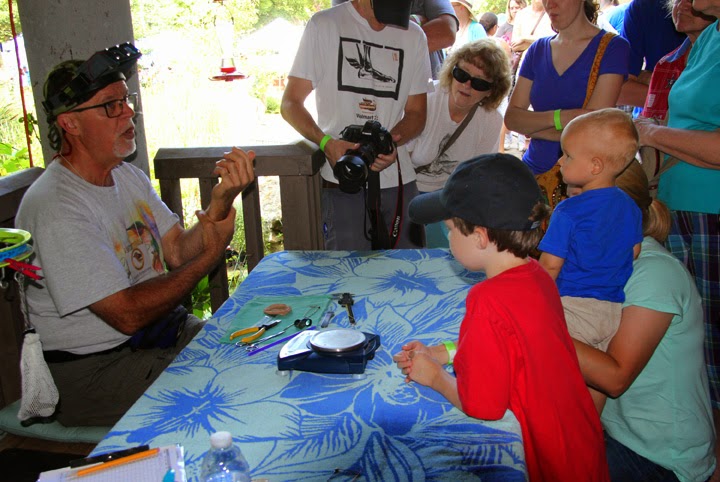It is fascinating and exciting to see the transition of activities and birds as summer moves into fall. What our banding team captures in the mist net tells that story of change.
Patty Ford and Eddy Whitson set up a mist net in one of the net lanes.
Above, Patty Ford, stretching a mist net to its end pole.
Today's session was also busy, but the story moved from breeding season to migration. Above and below, a beautiful Magnolia Warbler. Even with their fading fall colors, warblers are stunning.
Magnolia warblers are boreal forest breeders, breeding in Canada and the northeastern U.S. This time of year they are on their way to wintering grounds, mostly in Mexico and the West Indies to Panama, fattening up along the way.
Above, the beautiful tail pattern of the Magnolia Warbler.
One of the indicators of a healthy, migrating bird are the fat deposits found on the bird's belly indicating that the bird has met its nutritional needs well enough to store fat that will sustain it during its long journey. In the image above, the oval, light, bulging area shows the bird's fat deposits which, on the banding report, were recorded as level "three" (zero indicates no fat).Above, a Palm Warbler showing its new band. Billie Cantwell is holding the bird in a bander's grip while she consults Pyle's Guide for details on aging. Below, she is examining the wing. Mark Armstrong is weighing a bird on the scale. A small stocking is placed over the bird's head to keep it calm until weight is measured, which only takes a few seconds.
Palm warblers breed in the northern boreal forests of Canada and are moving through Tennessee now on their way to more southerly wintering territories along the coast.
In the image above, you see a Palm Warbler's wing and tail as Mark and Billie consult on the freshness and color of feathers to help determine the bird's age.
Palm Warbler
The banding table. Mark Armstrong, Master Bander (left), Billie Cantwell, banding apprentice, and Janie Kading recording, all members of the Knoxville Chapter of the Tennessee Ornithological Society.
Another beautiful wood warbler species--the Tennessee Warbler.
Billie uses a straw to blow feathers away from the skull. The skull of a young bird is pink. Because a bird's skin is transparent, other charateristics of growth and age can be found from examining the skull.
Tennessee Warbler
Billie opens her hand and the Tennessee Warbler pauses for a moment before it flies away.
A beautiful male Eastern Bluebird. Several bluebirds were caught in adjacent nets and were calling to each other while held in bags waiting to be processed. Their calls helped us locate them (which bags) and they were processed and released in a short amount of time.
Eastern bluebirds wander in family groups during the late summer and fall months and remain in Tennessee during the winter. They are often joined by northern birds and maintain a wintering flock to aid winter survival.
Above, Billie bands a male Eastern Bluebird, and below, an image of the dark tips on his wing feathers
In addition to Western Palm Warblers, Tennessee Warblers, Magnolia Warblers and Common Yellow-throats, the Oven Bird was our fourth warbler species for the day.
Always a favorite, this beautifully marked ground-nesting warbler breeds in Tennessee. This time of year the species is moving to northern South America for the winter.
Situated on more than 410 acres along the French Broad River, Seven Islands State Birding Park includes raparian zones (where land and water meet) and open grassland habitat planted with native grasses, wildflowers, shrubby fruit-bearing plants, and trees, providing favored habitat and food sources for many grassland species and migrating warblers.
Visit my previous posts on bird banding.
More views of the Oven Bird
More information on Eastern Bluebirds: Bluebird Family
Knoxville Chapter, Tennessee Ornithological Society
Visit the Knoxville Chapter of TOS on Facebook
Seven Islands State Birding Park
Seven Islands Wildlife Refuge now Seven Islands State Birding Park






















































